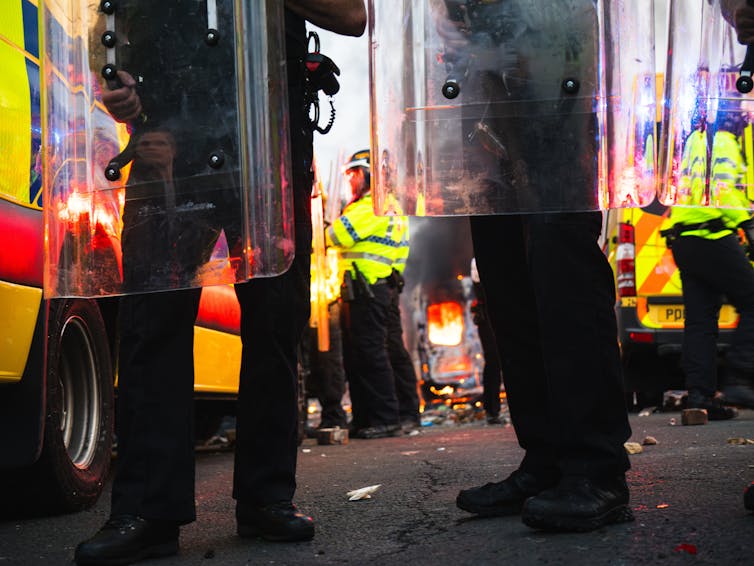Why police released the ethnicity of Liverpool parade crash suspect
https://theconversation.com/why-police-released-the-ethnicity-of-liverpool-parade-crash-suspect-255462 Share article
Within hours of a driver ramming into a crowd at Liverpool’s Premier League victory parade, injuring 65 people, Merseyside Police shared in a press release that they had arrested a suspect. Unusually, the announcement included the race and nationality of the person arrested – a 53-year-old white British man.
This was a stark contrast to the previous summer, when speculation about the ethnicity of a 17-year-old arrested for the murder of three young girls in Southport led to public disorder and riots around the country.
The question of what police and the public can say about an ongoing legal case and when is governed by contempt of court laws, which cover a wide range of behaviour in the UK. They prevent conduct which may disrupt legal proceedings, such as shouting out in court or otherwise causing a disturbance. They also prohibit publications which create “a substantial risk” that legal proceedings “will be seriously impeded or prejudiced”, and ensure that court orders are followed.
A recent House of Commons report suggested that the laws of contempt are not fit for the social media age. The report came after the public disorder which followed the murders of three girls by Axel Rudakubana in Southport in July 2024.

Want more politics coverage from academic experts? Every week, we bring you informed analysis of developments in government and fact check the claims being made.
Sign up for our weekly politics newsletter, delivered every Friday.
It is widely accepted that in the Southport case, misinformation spread via social media – specifically, that the attacker was a Muslim asylum seeker called Ali-Al-Shakati – helped to fuel the disorder. Merseyside Police’s decision to quickly publish the ethnicity of the man arrested in Liverpool suggests they were acting to prevent a repeat of the August 2024 riots.
The police were restricted in the information they could release after Southport. Separate from the contempt laws, the Children and Young Persons Act prohibits the publication of material that may identify a person under 18 involved in youth court proceedings, and a judge may order anonymity in other criminal proceedings.
The laws of contempt also prohibited the release of information which might have prejudiced any future trial. For example, that Rudakubana had previous criminal convictions and had been referred three times to Prevent, the anti-terrorism scheme.

The police did try to combat false information about the case in the days following the Southport attack, but it was too late. They shared that the suspect had been born in Cardiff and that the name circulating on social media was incorrect. However, they could have released more information more quickly, even under the current contempt laws, including details such as Rudakubana’s ethnicity.
The Law Commission, an independent statutory body charged with reviewing the law of England and Wales and suggesting reforms, has said it is an “open question” whether the publication of more information could have prevented or mitigated the disorder after Southport.
But the events after Southport are probably why Liverpool was handled differently. Merseyside Police broke from their previous approach of not releasing ethnicity details (except in cases of missing persons or people on the run). Earlier in May, the police inspectorate published a report on the Southport response, saying police forces “need to better appreciate how fast-moving events will require them to counter false narratives online”.
However, simply releasing the race of the man arrested in Liverpool hasn’t fully filled the information void. A man’s photo was circulated on social media, wrongly identifying him as the person arrested.
It also risks setting a precedent for future cases. If police release a suspect’s ethnicity, some people will make assumptions about whether their ethnicity is linked to a motive for an attack, and may spread misinformation that may prejudice a trial or cause disorder. But if they don’t release the ethnicity, some people may still make assumptions about why police have kept it secret. In either case, misinformation is likely to spread.
Fit for the social media age?
Both of these cases raise concerns about whether current laws are fit for purpose, in an age when information spreads quickly – regardless of whether it is true – on social media.
Regardless of what the police make public, the real challenge is that anyone with a smartphone can instantly comment on any event, and may not know they are putting themselves at risk of committing a contempt of court offence.
In 2019, actress Tina Malone received a suspended sentence of eight months for breaching a court order prohibiting the release of information about the murderers of James Bulger. She shared a social media post which claimed to provide the new identity and a picture of Jon Venables. Malone told the court that she was unaware that she was doing anything wrong.
Newspapers have often been the subject of contempt of court cases. But in theory, anyone who shares a post by a publication later found to be in contempt could be implicated too.
Committing contempt can carry a sentence of up to two years’ imprisonment and an unlimited fine. Stephen Yaxley-Lennon, also known as Tommy Robinson, was recently released from prison, where he had been serving a sentence for repeatedly breaching a court order.
The attorney general has launched campaigns to educate the public on the risks, but whether they’ve had any effect is questionable. Even politicians, including those in government, have made social media posts which come very close to being in contempt of court.
The Law Commission recently described the contempt laws as “disorganised and, at times, incoherent”. It launched a consultation in July 2024 on proposals to reform the law.
The laws of contempt, which have developed piecemeal over centuries, are not well known or understood. But they are an important part of the legal system, and they attempt to strike a balance between freedom of expression and the right to a fair trial, and to ensure that both victims and defendants receive justice. In the current climate, they need to be made much clearer.
